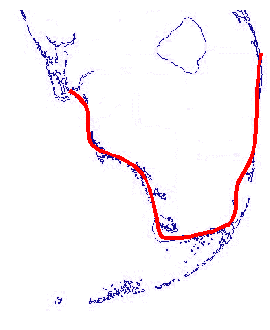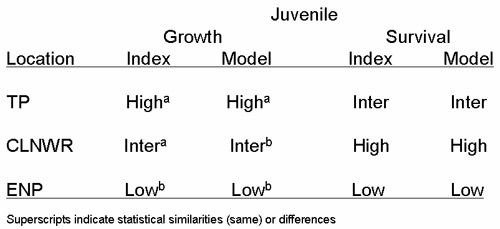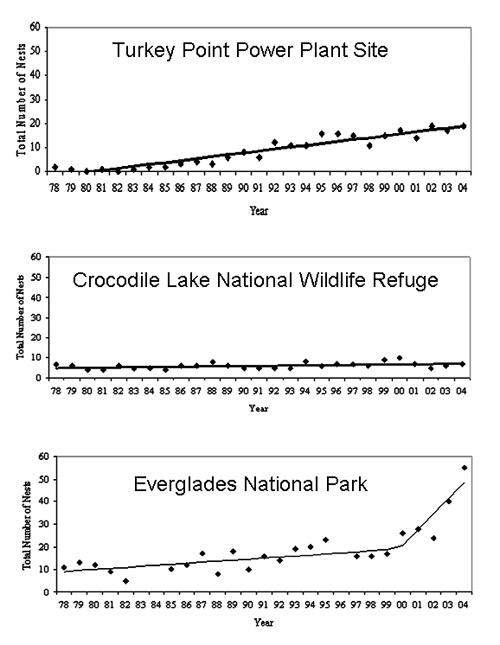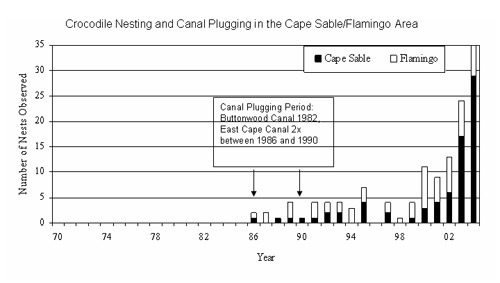The Role of the American Crocodile (Crocodylus acutus) as an Indicator of Ecological Change in Everglades Ecosystems
Authors
Michael S. Cherkiss, Laura A. Brandt, Kevin L. Chartier, Jerry Lorenz, Mark Miller, Mark W. Parry, Leonard G. Pearlstine, Kenneth G. Rice, Zongbo Shang and Frank J. Mazzotti
Introduction
Habitat loss has been the primary factor endangering the American crocodile in Florida. When crocodiles were declared endangered in 1975 scant data were available for making management decisions. Field and laboratory data suggested that low nest success and high hatchling mortality provided a dim prognosis for survival. Results of intensive studies conducted during the late 1970's and early 1980's by the National Park Service, Florida Game and Fresh Water Fish Commission (now Florida Fish and Wildlife Conservation Commission), and Florida Power and Light Company resulted in a more optimistic outlook for crocodiles in Florida. Monitoring programs were established for the three nesting locations, Everglades National Park, Crocodile Lake National Wildlife Refuge and the Turkey Point Power Plant site. These monitoring programs focused on nesting ecology and growth and survival of crocodiles. New issues face crocodiles in Florida today. Florida and Biscayne bays have undergone a number of changes that have caused a great deal of concern for the health of these ecosystems. Efforts are being made to improve Florida Bay and Biscayne Bay. As with other species of wildlife in southern Florida, survival of crocodiles and success of their nests have been linked to regional hydrographic conditions, especially rainfall, water level, and salinity. Alternatives for improving water delivery into South Florida estuaries may change salinities, water levels, and availability of nesting habitat in receiving bodies of water.
In South Florida, there is a unique opportunity to integrate endangered species recovery and conservation with ecosystem restoration and management. The purpose of this poster is to review results of monitoring and modeling programs for C. acutus that can be used as a basis for assessing and evaluating population responses to restoration projects.
Crocodile Natural History
- The American crocodile is a primarily coastal tropical species reaching the northern end of its range in southern Florida
- Undiscovered until 1869, the American crocodile has always been considered rare in Florida
- Historic distribution in Florida extended from Palm Beach County to Charlotte County including the Florida Keys
- The American crocodile is greenish-grey in color dorsally and white or yellow ventrally
- In Florida, C. acutus males reach about 4 meters in length while females reach 3.5 meters
- American crocodile habitat is defined as mangrove lined ponds, creeks, coves, shorelines, and man-made ponds and canals
- American crocodiles are found in coastal areas in fresh to hypersaline water although most are found in waters of lower salinity
- When declared endangered in 1975 the population of C. acutus in Florida was estimated to be as few as 200-400 individuals
- Current population estimates are around 1000 juveniles and adults
- The American crocodile in Florida is currently under evaluation for reclassification from endangered to threatened
 |
 |
| Distribution of the American Crocodile | Historical distribution in Florida of the American crocodile |
Crocodiles and CERP
- Restoration of freshwater flows to estuaries and salinity regimes will increase growth and survival of crocodiles
- Restoration of location of freshwater flow will result in an increase in relative density of crocodiles and hence, nesting effort in areas of restored salinity patterns
Monitoring and Assessment
- Juvenile growth and survival and nesting of the American crocodile are being monitored as part of RECOVER MAP
- Quarterly surveys to capture crocodiles are conducted throughout the current range of the American crocodile in Florida. Over 50% are recaptures we can measure growth and survival
- Surveys for nesting effort and success are conducted during the April-August nesting season
- All research and monitoring data collected for crocodiles in Florida between 1978 to 2004 have been compiled and are being analyzed and evaluated for suitability in setting performance measures and measuring ecological responses
- To meet a management driven time frame the initial analysis of growth and survival of crocodiles was done using indices of relative growth and survival. We have since applied statistical models to the crocodile data and can now evaluate effectiveness of using relative indices
- Patterns of growth and survival were similar for indices and models, suggesting that indices were an effective use of existing data to meet management needs, however we can now do better
- The number of crocodile nests has increased in Florida between 1978 (21) and 2004 (81). Some nesting areas were more variable than others and, for example, monitoring nesting in ENP for any given 3-5 year period would yield very different perspectives on the trajectory of the population. This emphasizes the importance of long term studies
- Changes in nesting of crocodiles corresponds with ecosystem restoration activities. After Buttonwood and East Cape canals in Everglades National Park were plugged in the 1980's to reduce saltwater intrusion into interior areas of Whitewater Bay and Cape Sable, crocodiles responded positively by increasing nesting effort and success. This suggests that restoring salinity patterns in estuaries can have a positive effect on this indicator and that monitoring is effective at determining population responses. It also indicates that nesting effort and success should be added to growth and survival as performance measures

Crocodile Survey Routes

Crocodile Nesting


Modeling and Evaluation
- Ecological models are needed for evaluation and assessment of alternatives for restorations of Greater Everglades ecosystems
- Crocodiles can be used to evaluate restoration alternatives for Florida and Biscayne Bays
- The purpose of this project is to develop a salinity based habitat model for crocodiles to evaluate restoration of freshwater flows to mangrove estuaries using output from the SICS model. This poster presents analyses based on a draft habitat suitability model
- The suitability model is based on three parameters: hatchling growth and survival, forage production, and forage availability
- The monthly calculations for times of high water (the months of August through December) and for times of low water (the months of January through July) are each the weighted geometric mean of the respective environmental variables
- Hatchling growth and survival index is calculated as the arithmetic mean of a salinity factor and a proximity factor (i.e. distance from known nesting locations)
- The yearly index is calculated as the average (arithmetic mean) of the monthly indices, using five months of high water index calculations and seven months of low water index calculations
- Food production and availability curves were created using modifications of relationships developed for Roseate Spoonbills by Jerry Lorenz
- Salinity curves were generated based on occurrence of crocodiles in relation to salinity and laboratory growth rates of crocodiles fed ad libitum
- We created a spatially explicit model of potential habitat for the American crocodile in Florida to be used as a basis for a habitat suitability model to evaluate and compare restoration alternatives and a population viability model to determine if the amount of crocodile habitat is adequate to support a viable population
- Acceptable habitat for crocodiles was considered to be all natural land covers (mangrove forest, tropical hardwood forest, coastal prairie, coastal marsh, and open water) that fall within the mangrove zone buffered into open water to accommodate foraging and inland for nesting
- Spatial distributions of land cover types where taken from the USGS Florida Gap Analysis Program (FLGAP) 1993/94 land cover classification

To demonstrate integration of the USGS Southern Inland Coastal Systems model and a crocodile habitat suitability model we asked:
What would be the impact of restoring the historical path of water flow into northeastern Florida Bay (see box on habitat map above)?
Restoring flow through Taylor Slough creates more suitable habitat than current conditions
(click for larger graphs)

Implications for Evaluation and Assessment of Ecosystem Restoration
- The American crocodile is an flagship endangered species representing importance of freshwater flow to estuarine health and productivity
- The linkage between salinity and growth and survival of crocodiles can be used for modeling and evaluation and monitoring and assessment of responses of the American crocodile to restoration of Greater Everglades Ecosystems
- Using a combination of growth, survival, and nesting of crocodiles allows for monitoring responses of crocodile populations at different temporal scales
- Increased nesting of crocodiles in the Cape Sable/Flamingo area of ENP was correlated with plugging canals in the 1980's suggesting that nesting itself is useful for monitoring responses to ecosystem restoration
- The 50% recapture rate is without precedent for a population of crocodiles and demonstrates our ability to measure growth and survival
- Existing databases of captures/recaptures of crocodiles allow for a statistical analysis of growth and survival. This analysis allowed for a geographic comparison of growth and survival of crocodiles.
- Our analysis of growth and survival of crocodiles through use of statistical models demonstrates that while indices of relative growth and survival used previously for establishing performance measures for crocodiles were OK, we now have better data for making informed management decisions
- Alternatives that restore flow through Taylor Slough will create more suitable habitat than current conditions
Acknowlegements
This project was funded by the Critical Ecosystem Studies Initiative, U. S. National Park Service, Department of Interior, the Greater Everglades Priority Ecosystem Science Initiative, U. S. Geological Survey, Department of Interior, and RECOVER MAP, U. S. Army Corps of Engineers, Department of Defense. Florida Power and Light Company, Florida Fish and Wildlife Conservation Commission, and the U. S. Fish and Wildlife Service all provided data for the analyses presented here. All applicable permits and approvals have been obtained and are available upon request.
Citation
Cherkiss, Michael S., Laura A. Brandt, Kevin L. Chartier, Jerry Lorenz, Mark Miller, Mark W. Parry, Leonard G. Pearlstine, Kenneth G. Rice, Zongbo Shang and Frank J. Mazzotti. (2006) The Role of the American Crocodile (Crocodylus acutus) as an Indicator of Ecological Change in Everglades Ecosystems. Poster presented at the Greater Everglades Ecosystem Restoration Conference. Orlando, FL.
More About This Project
Status, Distribution, and Habitat Relations of the American Crocodile in Florida




